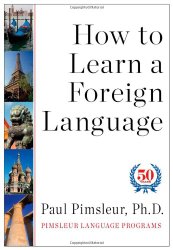 My Rating: 8 /10
My Rating: 8 /10
Title: How to Learn a Foreign Language
Author: Paul Pimsleur
Adults can learn languages faster than children. This might be surprising to people, but it makes sense when you think about it. Our brains work through association, matching up our actions and experiences over time so that we can adequately respond to the environment around us. A new born baby has a blank slate, no pre-existing associations that can be used to interpret language. So not only does a baby have to learn how to pronounce the word “dad”, she also has to learn the concept of a “dad”; how is “dad” distinct from “mummy”? How is “dad” distinct from all the other men that pass by her gaze?
Fortunately, with age comes a broader wealth of experience and knowledge that we can associate words against. We already understand the concept of a “dad”. In our native tongues, we could probably provide a nuanced description of surrounding concepts such as parenting styles, genealogy, nature versus nurture, and masculinity. All that’s left to learn with a new language is the vocabulary and grammar to express these ideas in a different way. Sounds easy doesn’t it.
Everyone can learn a new language
Fortunately when learning to speak a new language there are only three things you need to master: Pronunciation, Grammar and Vocabulary. Maybe an additional fourth thing if you want to be useful in conversations: listening / comprehension.
For even the most complex languages, a detailed description of the grammar could be described succinctly within a 100 pages. That’s something that could be read through in an afternoon. Internalising this information is more difficult though then simply reading the abstract descriptions. Active speaking is required to internalise this information. Pimsleur provides anecdotal evidence that grammar is best learned organically through speaking in the target language, rather than studying formal grammar classes or from textbooks.
Pronunciation can be a major stumbling block when learning languages. Different languages require entirely new sounds that don’t exist in your mother tongue. Japanese speakers mix the English ‘L’ and ‘R’. Indonesian rolls the ‘R’ sound. The simple act of making a new sound can be surprisingly difficult. I still struggle to pronounce the Cantonese word for me/I (‘ngo5’, 我) sound correctly, even when I am actively thinking about it. It is important to accept that you don’t need to perfectly pronounce everything from the start. Sounding native takes time, but if you make some mistakes people will still (mostly) understand you.
That leaves the final key challenge – the development of a working vocabulary. In your native language, you probably know 10 or 20 thousand words. The vast majority of this is used only sparingly. To be considered conversationally fluent, you just need several thousand words at your disposal and the ability to string them together as necessary. Learning ten words per day, the required vocabulary could be learnt within a year. All that’s left is to practice putting them into meaningful sentences.
Fortunately many languages borrow words from others, so you may even start your journey with a head-start. An English speaker can probably guess the meaning of about 20% of French words. As a result, English speaking learners of French have a natural advantage over people learning non-european languages, such as Korean.
How difficult is your language?
The US Foreign Services Institute has put together rankings of the relative difficulty of learning different languages for English speakers. I’ve seen various versions of this, but the version given in the book is given below:
Group 1 (Easiest) – French, German, Indonesian, Italian, Portuguese, Romanian, Spanish, Swahili
Group 2 – Bulgarian, Burmese Greek, Hindi, Persian, Urdu
Group 3 – Amharic, Cambodian, Czech, Finnish, Hebrew, Hungarian, Lao, Polish, Russian, Serbo-Croatian, Thai, Turkish, Vietnamese
Group 4 – Arabic, Chinese, Japanese, Korean
These type of rankings are pointless – in my opinion. The thing that will most influence your perception of a languages difficulty will be your genuine motivations for learning the language. A sufficient motivator will allow you to learn any language. If you don’t have a motivator then you won’t. These motivations can be: a boy, girl, friends, a desire to understand a culture, or basic necessity to communicate when your native language won’t suffice. These motivations probably won’t include a compulsory class in school.
How fluent do you want to be?
Your motivations will also influence the level of fluency you hope to achieve. Once you understand your motivations you can probably match up your minimum ideal fluency with the ratings below.
- Elementary proficiency – Able to satisfy routine travel needs and minimum courtesy.
- Limited working proficiency – Able to satisfy routine social demands and limited work requirements.
- Full professional proficiency – The person uses the language fluently and accurately on all levels pertinent to professional needs.
- Native or bilingual proficiency – Speaking proficiency of an educated native speaker.
All of these are achievable if you have the motivation. They are all achievable if you have the time. So what are you waiting for? Get to it.
– Stephen
Related Resources
Amazon – How to Learn a Foreign Language by Paul Pimsleur
Pimsleur language learning programs – Progressive lessons in over 50 languages.
Estimated time required to achieve Level 3 (professional) fluency in different languages.
Share this:
